The external similarities of these two breeds amaze any ignorant koshatnik. In this article, you will find all the differences between British cats and Scottish cats and find out which breed is best for you and why. Each of the representatives of the cat's world has its own special habits and character.
Differences of British cats from the Scottish
Table of differences in the appearance of two rocks according to world standards
| Body parts | British Shorthair and Longhair Cat | Scottish Fold and Straight Cat |
| Head | Oval shape, with a clear contour of the chin and strong jaw. It resembles an owl's head (this is one of the main differences of the Scots). | Round shape, with strongly developed cheekbones and prominent cheeks. |
| Ears | Straight and short, with rounded tips. Widely set and slightly out of the way. | The Straight Scotsman (Scotty Straight) - straight, narrower at the base, are set wide and vertical. The Folded Scotsman (Scottish Fold) - folded in about half, forward ears. Differs thick folds. |
| Eyes | Round, far from each other. The color depends on the color of the coat. | Round, widely set. The view of the Scots is reminiscent of the child's view, so the breed lovers endowed them with the expression "babyface". |
| Nose | Straight, with a small depression at the forehead. | Small, but voluminous, has noticeable expansion at the base. |
| Torso | A squat, slightly elongated, stocky body with a broad and massive rib cage. | In comparison with the British, it has more elegant body features - of moderate length with rounded forms. The thorax is also well developed, but more even from the shoulders to the pelvis. |
| Paws | Short and powerful paws, thanks to which the animal seems larger than the Scottish brethren. | Medium length, slender and proportionate to the whole body. |
| Tail | Short, thick and rounded at the tip. | It has an average thickness and length, more flexible and slightly pointed at the tip. By the tail can distinguish a Scot with an unaided eye. |
| Wool | It has a double structure, does not adhere to the body, it is elastic enough. The touch is soft, like a plush. | Also plush, very thick and dense. The difference is that it often depends on the color and time of the year. |
British or Scottish cat: whom to choose
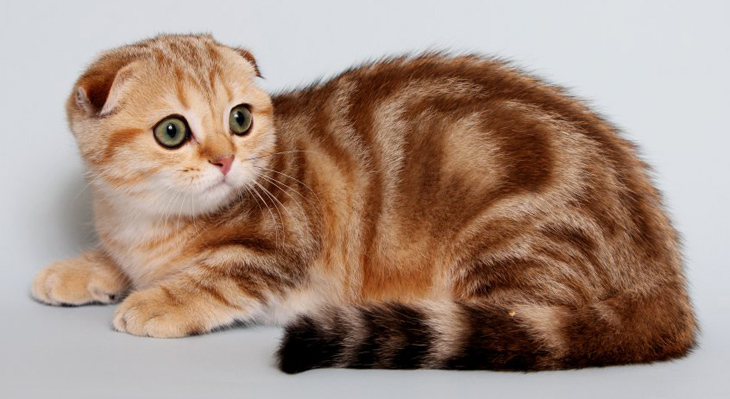
Scottish lop-eared cat
Despite the fact that the British and Scots have a similar appearance and the rules of caring for it, the nature of animals has obvious differences:
- Mutual relations with the owner. British cats are very fond of seclusion and do not particularly need attention to their aristocratic person. But the Scots prefer good communication with their favorite breadwinner and often ask for hands to be stroked.
- Mutual relations with children. Both breeds of cats love active games and get on well with the child in the house. However, the British does not like excessive obsession in those moments when she wants to be alone. Of course, she will not scratch a small "robber", but she will try to hide. In the opinion of most owners, families with children are best suited Scottish Fold (Scottish Fold), who are ready to play all day, never showing negative emotions.
- Unusual habits.Representatives of the Scottish breed of cats can often stand in the posture of a "post", and also sit on the pope. And though from the side such behavior can seem like an amusing pampering, pets thus simply mash their vertebrae. The British do not usually have such a habit.
- Fear of heights. Most of the lop-eared tartlets due to the special arrangement of the vestibular apparatus are very afraid of heights. Therefore, in spite of the fact that animals like to have fun for a long time, they will never jump on the curtains and tear off the chandelier from the ceiling. And here british cats often enough to climb higher, to look down on the situation in the house. By the way, at the same time they always make the leader of the pack unruffled muzzle!
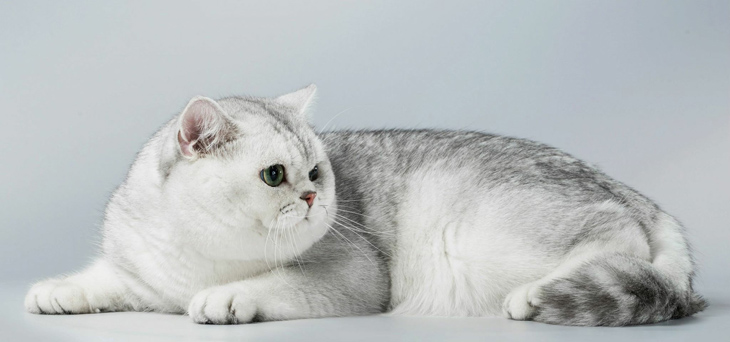
Straight scottish cat
To finally determine which of them still choose, we recommend that you read the following tips:
- When choosing a pet, hold the Scottish and Fold kitten on your hands. Feel the difference in the quality and length of the wool cover.
- Carefully inspect and compare the appearance of animals. Do not forget that the Fold of the British does not exist!
- When buying any kitten, make sure that the next of kin are of the same breed. Scottish cats, like the British, do not allow crossbreeding with other breeds. In addition, for the breeding of a Scottish cat one of the parents must be a lop-eared one, and the other - a prickly one. Another mating can lead to defects at the genetic level. A mixture of Briton and Scotsman you'll never find in a decent nursery thoroughbred moustached.
- Pay attention to the cost of animals. As a rule, the folds are somewhat more expensive. But another indicator can also serve to document the purity of the breed, the pedigree, the color of the pet and its class (show, breed or pet).
- So that you are not deceived with the breed or did not sell the mongrel at all, buy the animal in the nursery, which you will be advised by a club or a good acquaintance. It is less safe to buy Britons from the hands, but only in the sense that they have a high probability of the absence of diseases of the musculoskeletal system.
The main similarity of the two plush breeds is that each of them you will love selflessly. And making your choice in favor of one of the pets, be guided by the heart. It will help you find a loyal and obedient friend for many years.
The answer to this question depends on your personality and the situation in the house. Some people are more suited to British cats, to someone - Scottish. We will tell you in which case the Briton is suitable, and in what way is the Scot, after which you will be able to determine your preferences.
Appearance of British and Scottish cats
Externally, British and Scottish cats are so similar that it is difficult for a man in the street to discern them, especially in his childhood. This is because they have common roots, and more precisely, the Scottish breed was bred with the active participation of the British, which appeared much earlier. Until recently, mating between these two breeds, so often we are not dealing with purebred cats, but with mixes. But then we'll still talk about purebloods, since half-bloods can manifest completely unpredictable genes.
The average thoroughbred Briton is larger than a Scot (British cats grow to about 4-7 kg, Scottish - up to 5-6 kg). He has a wide, heavy bone, which determines the constitution of the body. Therefore, if it is very important for you that the cat was huge, then the briton will do better. And then pay attention to the kitten's parents, they too should be as large as possible, and the kitten itself - the largest in its litter.
Scots are more graceful and graceful, they are lighter and more compact. They have longer and slender paws, a longer and thin tail.
If you want a lop-eared cat, it's only a Scot. Fold of the British, contrary to the opinion of the ignorant, there is no such thing. If the breeder says that he sells the lop-eared Briton, run away from him: either he is lying, or he is illiterate and arranged an unauthorized mating between the British and the Scot (individuals from such crosses have serious health problems).
The Scots and Britons have slightly different muzzles. The British have more ears, the neck is stronger and wider, and the muzzle itself is much larger with more pronounced cheeks. At the best representatives of the breed, especially in cats, the cheeks are simply huge, it seems that they lie on the shoulders.
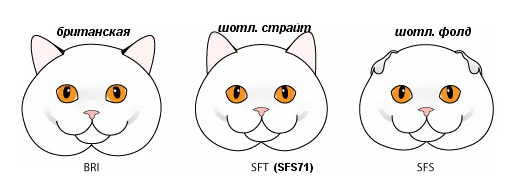
Scottish and British breeds have many variations of wool colors. They are almost any color, although among the British, there are often blue (in the world of non-specialists this color is called gray). Among the Scots, the most common colors are solid blue, brown, lilac, and also point, lilac, chinchilla, whiskas and smoky.
The British and the Scots are short and half-long wool.
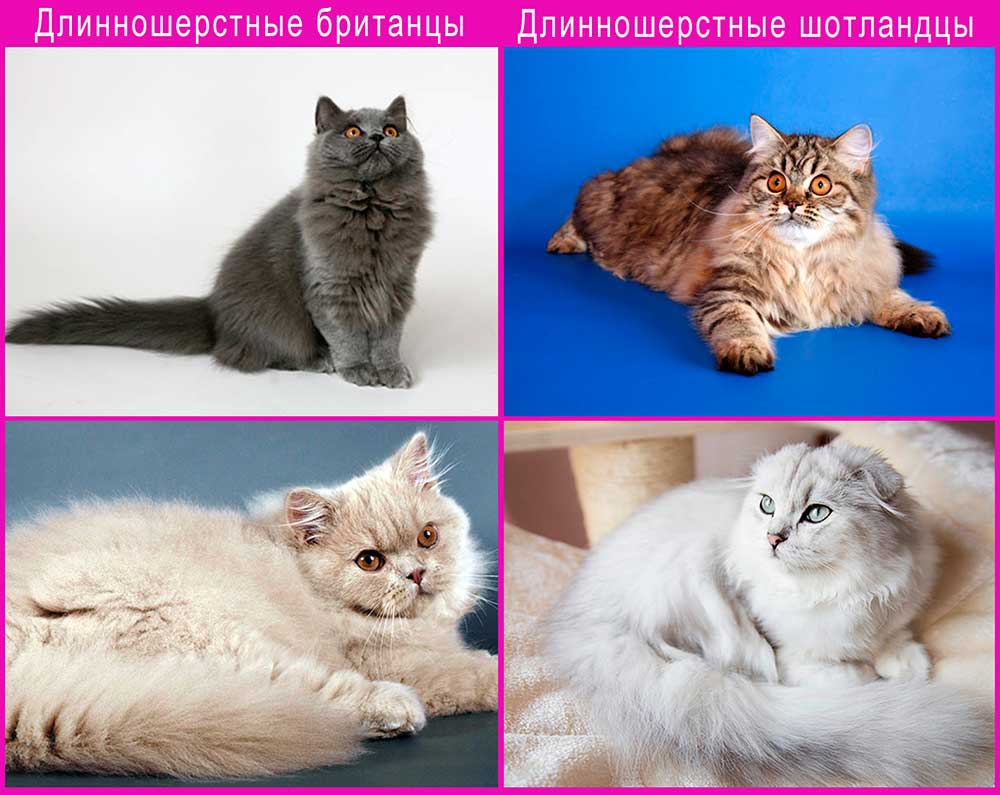
The nature of British and Scottish cats
The character of the Scottish and British cats is different. The British are more suitable for families without children and for people who are not at home for a long time, since British cats, for the most part introverts, isolated, like solitude, do not suffer very much from the absence of the owners of the house. For this quality they are even called cats for businessmen.
Scottish cats are great extroverts, focused on communicating with people. They are more sociable and curious, so they are always present next to the owners, and if people are very long absent from home, Scottish cats are bored. For this reason, the breed is considered suitable for large families, where there is always someone at home.
At the same time, I would like to warn those who want to buy a kitty in order to be tormented by a child with their caresses. Neither the Scotsman nor the brother will tolerate this for long. Both breeds do not like hugs (except when they have a mood), do not sit on their hands and are not weak-willed pillows, with which you can do anything. Repulse aggression, as well as affection, both breeds can give, so too obsessive a child at risk of constantly walking with blood-splashed hands. Of course, the Scots and the British use cliches as weapons as the last argument, especially with regard to children.
If your children respect cats and are ready to play mobile games with them, rather than suffice, then they are suitable Scots: these cats are very fond of playing with people. The British are more lazy and periodically need complete seclusion. The Scots have such moments.
British cats will not get people with their attention and talk. Scots can behave obsessively, following the heels of following the owner, climbing by the arm, and especially talkative - also something on the way to tell.
The British are more restrained in expressing feelings, the Scots are more open. The British are loyal friends, but loyalty does not grow into affection. As a rule, they do not choose any one member of the family for the love, but they treat everyone exactly. Scots tend to create an idol who gets more attention. But this does not happen in all cases: often they love all family members.
The common features of the two breeds are courtesy, friendliness, aristocracy, easy accustoming to the toilet and scratching. Both breeds of average temperament, rather calm, do not dirty, are not aggressive, not rancorous, not touchy and not vindictive.
The habits of British and Scottish cats
Breeders have noticed some features of the behavior of Scottish and British cats, which can not be called peculiarities of character, these are, rather, habits.
It is believed that British cats more like height, so they happily climb on the roofs of chiffoniers, surveying everything around, and Scots are afraid of heights. This feature is really present: Scots are less interested in height, but sometimes they manage to climb higher if there is a convenient transition from several heights.
The British do not have ridiculous Scottish habits to sit in the pose of the Buddha and stand a column, like a gopher. So in terms of amuse the surrounding Scots win.
Health of British and Scottish cats
Both breeds are prone to fatness and like to eat well. But the British have this tendency a little more pronounced. The owners of cats of these two breeds should closely monitor the diet of pets.
Scots grow to about 2 years, the British - up to 3 years. This applies to males. Samochki stop in growth approximately in 1-1,5 years.
In general, British cats are considered a fairly healthy breed, because she is primordial. Scots also differ in good health, but with one caveat. Folders of Scots have a mutational gene that changes the quality of the joints for the worse. The Straight Scots have no such problem.
Still hesitate with the choice?
Do you know the saying "Feminism - until the first successful husband"? And with cats. You can not love them, but only until you have your cat. And you can very long choose, comparing all the parameters of a particular breed, until you meet that same CAT.
This is a standard situation, when a person decided that he would take such and such a breed, such and such a floor, of such and such color. A person comes to the nursery, and leaves with an animal of another breed, the other sex and a different color. How does this work out? The choice of a kitten is not logic, but emotion. You can tell yourself a million times that you will not take a cat, because you do not want to get involved with the problem of kittens and estrus. You can not want a certain color a million times. And then (by the way, it happened with the author of this article), you meet him or her, she or HE comes to you - and you understand: this is the most cat. It may be the wrong color, the wrong sex and the same breed, but a spark has crossed between you. It's like with people. Logic can suggest one, but the mind is always fooled by the heart.
What is the practical benefit of what was said for you personally? The risk to give advice: do not sit on studying theoretical materials for longer than necessary - go watch live kittens. You will be surprised how easy it will be to make a choice when you meet your CAT.
In the sixties of the last century on one of their Scottish farms from ordinary cat and cat, a white fluffy kitten with very interesting ears was born. Small, pressed to the round head, they were folded in the form of an envelope. They called this kitten Suzy. In the second offspring, her grandson Snow Ball and British cat named Lady May reproduced five amazing children. Lop-eared kittens laid the beginning of a pedigree for a new cat breed - the Scottish Fold. Professional breeders calculated the algorithm for breeding this species. So the Scottish cat entered our life.
Many believe that if a British cat participates in the binding with a folded cat, then a British lop-eared individual is born. In fact, this breed of cats does not exist.
It is important to know! It is allowed to cross only Scottish Fold cats with british cat or vice versa. Born of such a mating kittens, is attributed to the Scottish breed.
And if British lop-eared cat or British lop-eared cat, then it is only the participation of one British parent in the reproduction, and not the name of the breed. British lop-eared cat is actually Scottish.
Scottish Straight Cat and Scottish Folded Cat
As a rule, the Scottish Fold cat brings kittens with straight ears. But in a few calves, after three, four weeks, the ears fall, while the others remain sticking out. So there is a Scottish pryamouhaya cat. Scottish cats are divided into several types:
According to the shape of the ears:
- fold cats (Scottish fold);
- straight cats (Scottish Straight).
According to the length of the coat:
- fold cats (Highland Fold);
- straight cats (Highland Straight).
To have kittens with different structure of the ears - one of the parents must be a lop-eared one, the other with straight ears. This is an obligatory condition, which the breeders adhere to. The surprising strangeness of this breed lies in the fact that only on the 12th month of their life there are characteristic signs that allow attributing them to the home, tribal or exhibition type.
By what parameters and balls are these cats evaluated at international exhibitions?
Appearance. Symptoms of thoroughbredness
So, we know that the British lop-eared cat is the Scottish breed on the very grandfather, for which the following parameters are characteristic:
- Body. The Scottish cat is harmoniously composed, small in size. Graceful body has an elongated shape. Shoulder and femoral parts of the same width.
- Wool. Short fur is elastic - elastic, dense due to undercoat.
- Color. The most diverse from monotonous black, white, blue to multicolored-spotted, in stripes or with intricate patterns.
- Ears. Widely spaced, folded in half. Covering the auricle, hang down. Strongly pressed to the head.
- Eyes. Wide open, round shape. The color is in harmony with the coat color. There are cats with emerald, blue and yellow eyes.
- Nose. Wide, with a slight deflection.
- Paws. Medium length, graceful. With rounded pads.
- Tail. Thick at the base. Long with a pointed tip.
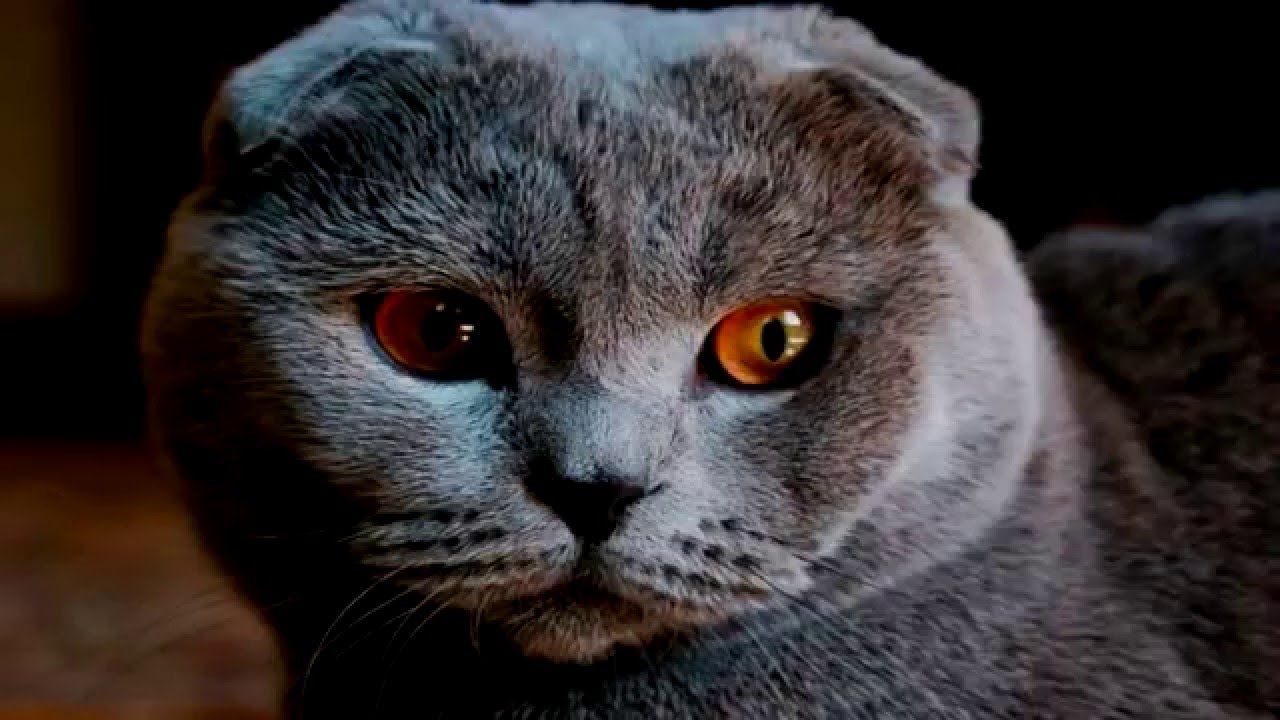
What a furry character
Lop-eared kittens are mobile, like to play. You will not see them, fighting wallpaper or hanging on the curtain. The games are moderately active.
- Enough smart. Quickly get used to the toilet. Sharps claws on the scratching pad. Do not spoil furniture upholstery. Fold cats and cats have a sense of self-worth. Well developed intuition.
- Quickly get used to the new situation and the hosts. Can feel the mood of a person and behave appropriately. Good nature does not allow aggression. They are non-null and verminous.
- Meow gently, muffled, which does not compare with the cries of some breeds of cats. Softly, gently and unobtrusively they will let know that they need something. Very patient.
- Friendly to people, despite their independent nature. They love children. They suffer even childish cruelty. Do not hiss and do not scratch.
- Are betrayed to whom they will choose. But they are friendly to the rest of the family. Never impose their company. Tolerant to neighbors around the apartment: other cats or dogs. They like to play with them.
The Scot, a peace-loving cat by nature, will not tolerate a cry and a rude attitude towards himself. Psychological protection will be that he will change his affectionate attitude towards a person, he will be afraid of him, and he may respond to rudeness with obvious aggression. You can not take it by the scruff of the neck and raise it. Having a pretty decent weight, a Scottish lop-eared cat feels pain. Especially the spine suffers. If you want to take the cat in your arms, hold it under your abdomen.
Training Scottish cats are amenable only under the condition of patience and consistency. And the training should resemble the game - with encouragement in the form of stroking and delicacies.
What physical activity is preferred
Scottish Fold - domestic. Cats are quite comfortable at home with sufficient food and toilet. But they will not be against short walks in the fresh air. On sunny days they like to lie in the grass. Lie down, substituting the muzzle to the sun's rays. Since childhood, and throughout life, do not lose their playful character. Willingly frolic with toys: balls, balls and artificial mice.
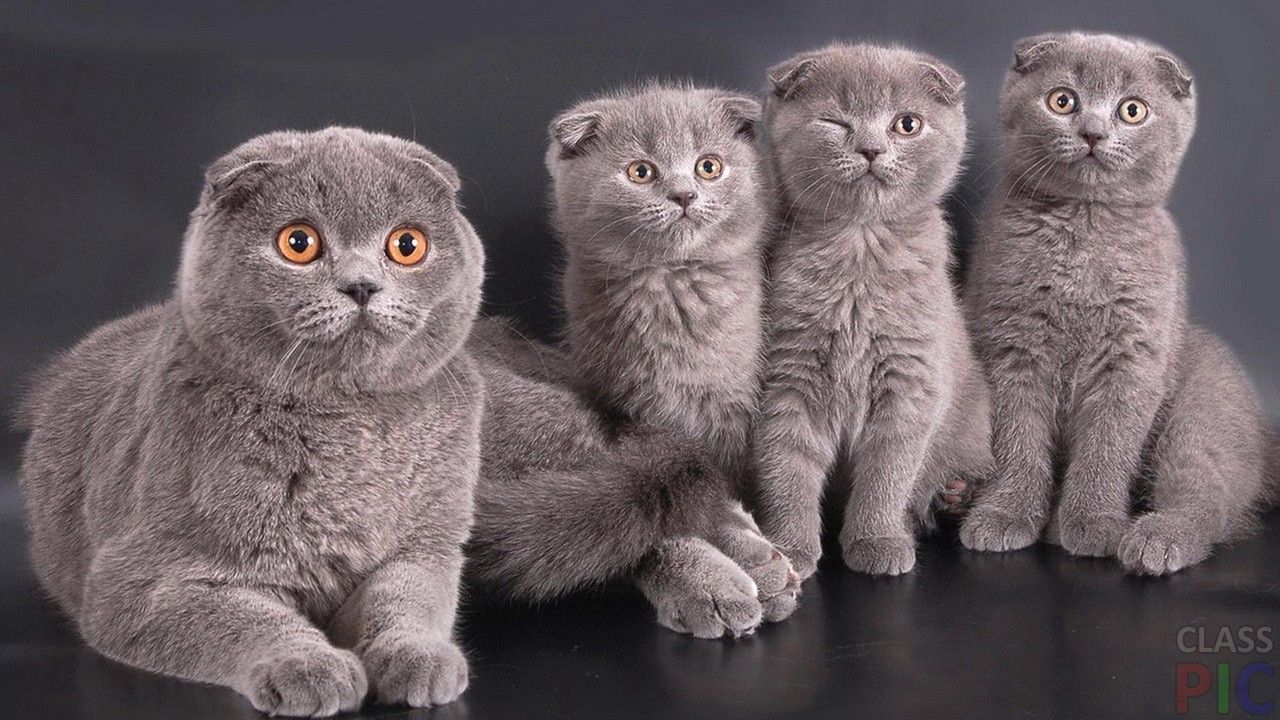
The natural aspiration to climb and the manner of arching the back strengthens the musculoskeletal system and the vestibular apparatus. Being domestic, have not lost the natural instinct of the hunter. Patiently and for a long time waiting for the moment of throwing on the prey in the form of a fly or a mouse. It is very interesting to watch how the Scottish Fold makes gymnastics - stretches out its paws forward, then gracefully turns on its back and quickly straightens the body, becoming a marmot. So Scottish cats maintain a good physical shape.
How to care for a pet
Scottish lop-eared cat by nature is very clean. Being a predator, his body does not emit sharp smells, so that the victim does not realize the danger. However, personal hygiene is very important.
- During the moulting season, it is necessary to comb out the cat at least once a week. This will prevent rolls of fairly dense and bulk wool. And it also saves you from having to clean carpets and furniture from cat hair. Cats like the procedure of combing out. They do not resist, willingly substituting their fluffy back.
- Wash the lop-eared stands as necessary - if the Scot floundered in the dust on the street, or he had fleas. They do not scream and do not try to get out of the bath with all their strength. In the water relax and give themselves to wash.
- The peculiar structure of the ears requires the need to clean them from accumulated sulfur and contaminants. Do the cleaning should be done carefully with a cotton swab using a special cleaning liquid. And only after consulting with the veterinarian.
- Once every three weeks, the animal is clipped. Do this with special scissors. In order not to injure the animal, remove part of the claw no more than two millimeters.
- The toilet tray must always be in the same place. Keep it clean. Cats are neat to pedantry. To wash the cat toilet do not use funds with a strong odor.
- Acquire a scribe longer than the animal itself. Cats like to stretch their body when claws are turned.
- Scottish Fold prefers to sleep in one place. The cushion should match its size. A cat's bed should not stand in a draft. Choose a secluded place where your pet can safely sleep and relax from the external bustle of the apartment.
What to feed the Scottish Fold?
To lop-eared kitten has grown healthy, it is necessary to provide his body with a sufficient set of nutrients.
Meat
First of all, it is natural meat of beef and chicken. Lean, not containing fat, which is pre-boiled. Raw meat and fish can lead to stomach upset and trigger a disease of the digestive system. And of course it should be pitted.
Cereals, rice
Milk is not recommended to give to adults because of their non-digestion of lactose. Do not feed fatty foods. This is detrimental to the health of the liver. Cereals, rice are useful in boiled form. You can add chopped chicken egg.
Vegetables
Vegetables and grass are a source of vitamins and fiber. They help to remove wool from the stomach, improve intestinal motility. To balance the nutrition of the cat, they feed the pet with a complex of vitamins and minerals destined for this breed. They get them in veterinary clinics or pet stores.
Fresh water
It is ensured that the cat always has free access to fresh water. Preferably filtered.
Important! For heart health and visual acuity, the animal requires an amino acid - taurine. It is present only in protein products.
Dry food
On the shelves of pet stores in stock and dry industrial feed for this breed. This is a balanced diet, which includes all the necessary elements for the healthy functioning of the body.
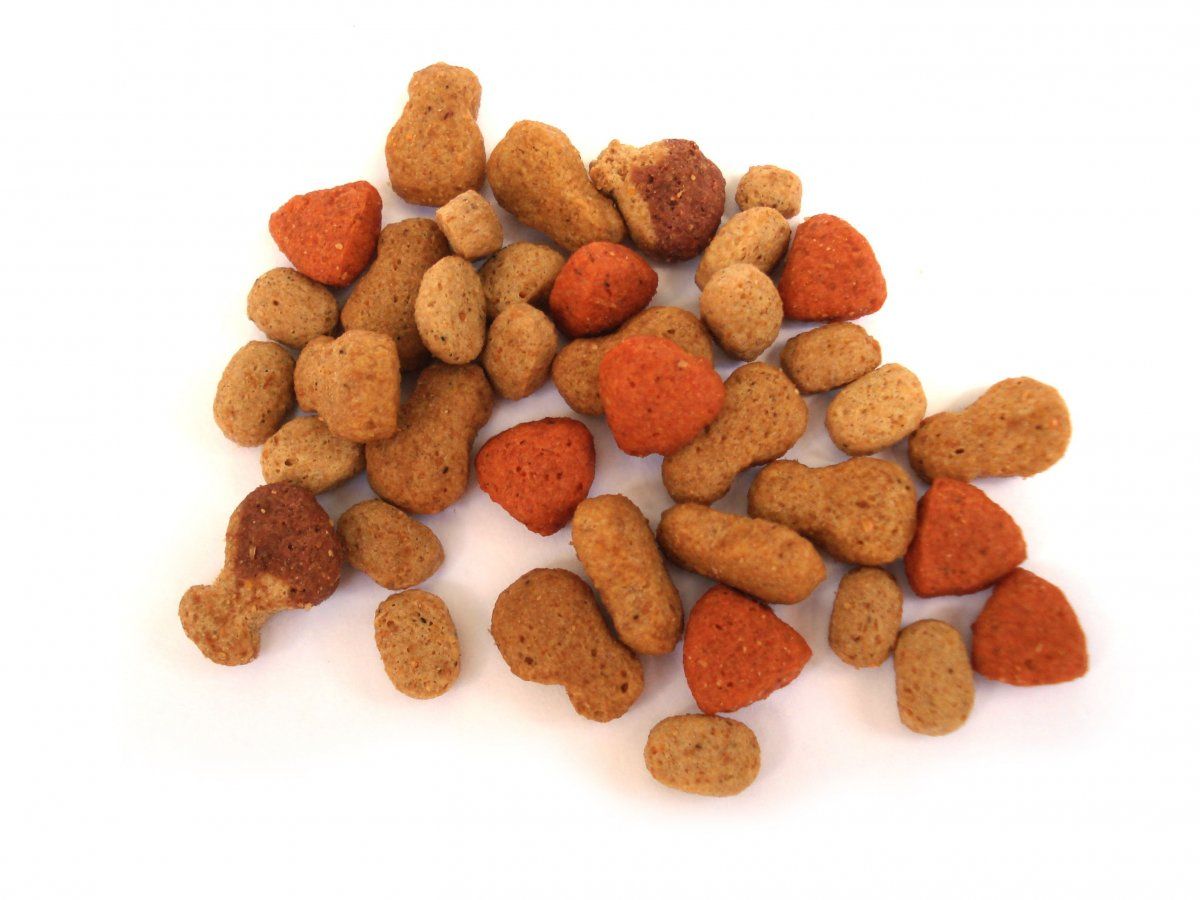
Newborn lop-eared kittens, provided that the mother is healthy, receive all the necessary substances for the full development of her milk within four weeks after birth. In the future, the food should be high in calories and nutritious.
Proper care for your pets will support their health. Will ensure a long and happy life. And Scottish cats will delight you with their cheerful and cheerful disposition. Observations and selection have proved that the British lop-eared cat does not exist as a species. Be careful when buying a cat.
Professionals involved directly in breeding cats, without difficulty, will answer what is the difference between a British cat and a Scottish cat, whereas to an amateur they may seem quite the same.
Brief historical digression
Information about the British cats are associated with the Roman Empire, the soldiers of which brought these handsome men to the islands, although the official standard was formed only in 1898, when the first pedigree was given to a representative of this breed.Scottish descendants of cat Suzy, who discovered a new sign in the form of ears folded forward, were recognized as an independent breed and registered only in 1966. They were a branch of the British, have undergone many disagreements, before they proved their worth as an equally interesting species of domestic cats.
Features of mating and breeding
To understand what the British and Scottish cats are, it is necessary to analyze some subtleties and special rules for the breeding of two breeds, prescribing a prohibition to cross them so as not to lose breed purity.Representatives of the British elite are selected to mate not just one breed, but also an identical color. Scottish Fold - Scottish folds can not become a pair not only with the British, but also with similar lop-eared individuals. They are allowed to knit only with Scottish Straight - direct producers, and in the offspring of both kittens will show both signs.
Key differences between British and Scottish cats
![]()
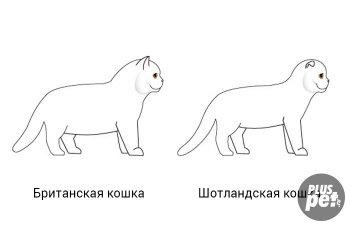
The complexity is the fact that these are very similar breeds - British and Scottish, the differences are most pronounced in the configuration and arrangement of the ears. Scots with straight ears are characterized by a narrower base than those of the British with sturdy slightly rounded auricles.
Scottish, growing up, retains the sweetness and childishness of the face, eyes can be of different shades. The tail is quite flexible in their average thickness. The British have expressive cheeks, dominated by a copper, often bright orange color of the iris. The tail is short with a characteristic rounded end.
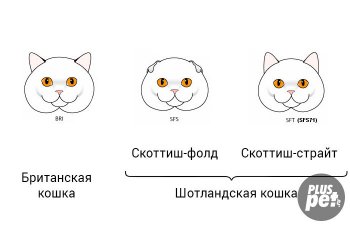
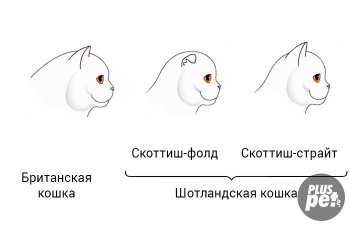
Comparing in more detail, what distinguishes the British from the Scottish, it is advisable to pay attention to the wool. In the case of tactile sensations, the straights have a silky, soft, very delicate texture, despite the exceptionally dense texture of the undercoat, which is slightly shorter than the awn. In the British, the undercoat and guard hair are equal in length, which creates a thick skin.
It is noted that the character of British cats balanced, sedate, slightly phlegmatic. They will allow you to stroke yourself, but they will not let you squeeze children, ignoring active games. Leaving from the intrusive communication, they like to climb higher, so that with the imperturbability of the leader they will survey the neighborhood.
Scottish pets are more sociable, playful, friendly. These are wonderful companions for children, ready to mess with them for a long time without aggressive reactions. Straightening the vertebrae, Scottish cats easily get up a "pole" or sit, which is beyond the power of other felines. Unlike the British, they are afraid of heights.
How to choose the right kitten
Of particular relevance is the problem of how to find the difference between Scottish kittens and British to make the right choice.It should be remembered that up to three weeks in Scotty ears do not show any characteristic differences. Only grown-up kittens can reveal a lop-eared, which has three degrees:
- folded in half raised ears with tips directed to the side or forward;
- pressed rather tightly to the head ears with a double fold in the form of pleating on the edge;
- ears with a pronounced third fold at the tip.
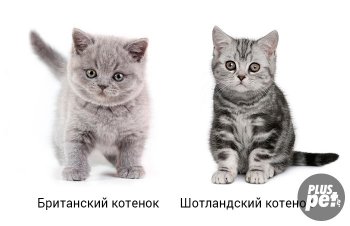 If you have to select a Scotch kitten with straight ears, you need to listen to the advice of experts, helping to distinguish it from the descendant of the old British breed.
If you have to select a Scotch kitten with straight ears, you need to listen to the advice of experts, helping to distinguish it from the descendant of the old British breed. - The Briton is externally associated with a plump, plump teddy bear on short legs. The Scotsman has a more graceful physique, refined paws, a lovely face decorated with perfectly round eyes.
- The neck of a British kitten is practically not visually detected, but in Scotts it is clearly visible.
- A special mark is checked in the pedigree. If it costs SFS - this is Scottish Fold, SFS71 - Scotsman pryamouhy, BRI - Briton.
This article I want to start with the most common misconception existing in the network and among people little knowledgeable in the breeds of cats - LISTENED BRITISH DOES NOT EXIST !!!
Only Scottish cats can be lop-eared, namely Scottish folds. So what is the difference between these two breeds?
From the point of view of an unenlightened cat who does not plan to breed, there is practically no difference between the Scottish cat and the British cat. Similar appearance, the same rules of courtship, a similar diet. However, for those who, together with their pupil, attend various exhibitions and pay special attention to the pedigree of the animal, the situation will be quite different.
The British breed is a national breed, it originated in the UK for a long time. In contrast, the Scottish breed is mutated. Her beginning, she also takes in the UK, where in 1961 on one Scottish farm came into being a kitten, who initiated a new breed.
The main difference in appearance is in the ears. They are a little bent forward and down the Scots. However, this does not apply to all Scots. Traditionally, Scotland breeds are divided into two breeds: Scottish Fold - Scottish Fold (from English tofold- fold, fold) and Scottish Straight - Scottish short-haired (from English straight-straight). Ears of the latter have a normal shape and do not sag, like the first.
If you compare the appearance of the Scotsman and the British, it can be noted that the British have a heavier bone, short and powerful paws, a massive head with widely set ears, thick cheeks. In Scots, the backbone should be more lightweight, which is compensated by their increased mobility and vigor, the paws are longer, the tail is also longer and tapering to the tip, a round head with high-set ears and a sweet expression of the muzzle. Wherein scottish cats and cats are even larger than British.

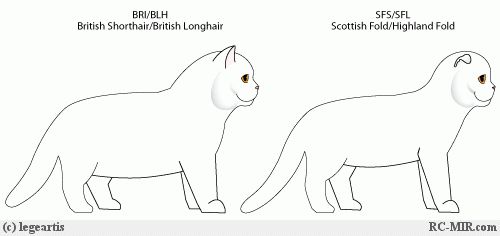
Schematic representation of the British and Scots.
There are also differences in breeding. If a British cat is required to get a British and a cat to breed only a British breed, a repetition like the Scots will result in a number of defects in the locomotor system and deviations that can easily kill the offspring. Kittens with deviations can easily be distinguished by a thickened tail and heavily curved paws that do not allow the animal to move. To date, such matings are strictly prohibited. For breeding Scots, one of the parents must be a subspecies of Scottish Fold, and the other - Scottish "pryamouhaya" or Scottish Straight.
If we talk about the character, the Scots are easy and love for the games. They easily find a common language, both with family members and with other pets, even if it's a dog or, for example, a guinea pig. Aggression is absent in them already at the genetic level. The British is more independent and does not need special attention to his majestic person. He feels great, even without having a long time of contact with a person. The fact that originally the given breed was intended for catching rats and mice is affected.
Conclusions:
1. The British is a purebred breed, and the Scottish is genetically bred.
2. In appearance, the main differences are noticeable in the structure of the paws, tail and, of course, the ears, which in one of the Scots subspecies are hanging.
3. According to the method of tying - the Briton admits only a combination of "Briton + Briton", and the Scot - "Scottish Fold + Scottish Straight", otherwise leads to defects at the genetic level.
4. By nature - the Scot is absolutely non-aggressive and very sociable. The Briton, on the other hand, does not like excessive obsession and prefers loneliness.

